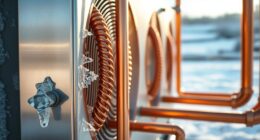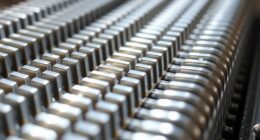Recognizing the difficulty of staying warm in freezing temperatures, we strive to demonstrate how high-quality heat pump systems stand out in delivering heat in chilly climates.
With proper insulation and the ability to extract heat from cold air, these pumps can overcome the challenges of extreme cold temperatures.
Plus, we’ll guide you on choosing the right size and offer tips for optimal performance.
Get ready to save energy and stay cozy with our expert advice.

Key Takeaways
- Advanced technologies enable heat pumps to operate effectively in extreme cold temperatures.
- Proper insulation is crucial for maximizing heat pump efficiency in cold climates.
- Heat pumps extract heat from cold air through a refrigeration cycle.
- Overcoming winter challenges, such as ice buildup and heat loss, is essential for maintaining efficient heat pump performance.
Understanding Heat Pump Technology in Cold Climates
We love exploring the efficiency of heat pump technology in cold climates. Heat pumps are known for their ability to provide efficient heating and cooling, but they do face certain limitations in cold weather. However, through innovative cold weather adaptations, these limitations can be overcome.
One of the key challenges is that heat pumps extract heat from the outside air, and when temperatures drop too low, the amount of heat available decreases significantly. To tackle this issue, manufacturers have developed advanced technologies that allow heat pumps to operate effectively even in extremely cold conditions. These adaptations include features such as low-temperature operation modes, defrost cycles, and enhanced compressor technology.
By incorporating these cold weather adaptations, heat pumps can continue to provide efficient heating even in sub-zero temperatures.
Transitioning to the subsequent section, another crucial factor that affects heat pump efficiency is proper insulation.

The Importance of Proper Insulation for Heat Pump Efficiency
Our focus now turns to the importance of proper insulation for maximizing heat pump efficiency.
Proper insulation is crucial for achieving optimal energy efficiency in a heating system. Insulation benefits heat pumps by reducing heat loss and preventing cold air infiltration.
When a building is well-insulated, the heat pump can operate more efficiently, as it doesn’t need to work as hard to maintain the desired temperature. This leads to lower energy consumption and cost savings for homeowners.
Insulation acts as a barrier, preventing the transfer of heat between the inside and outside of a building. By minimizing heat loss through walls, floors, and ceilings, insulation helps the heat pump to maintain a consistent temperature, resulting in improved performance and comfort.
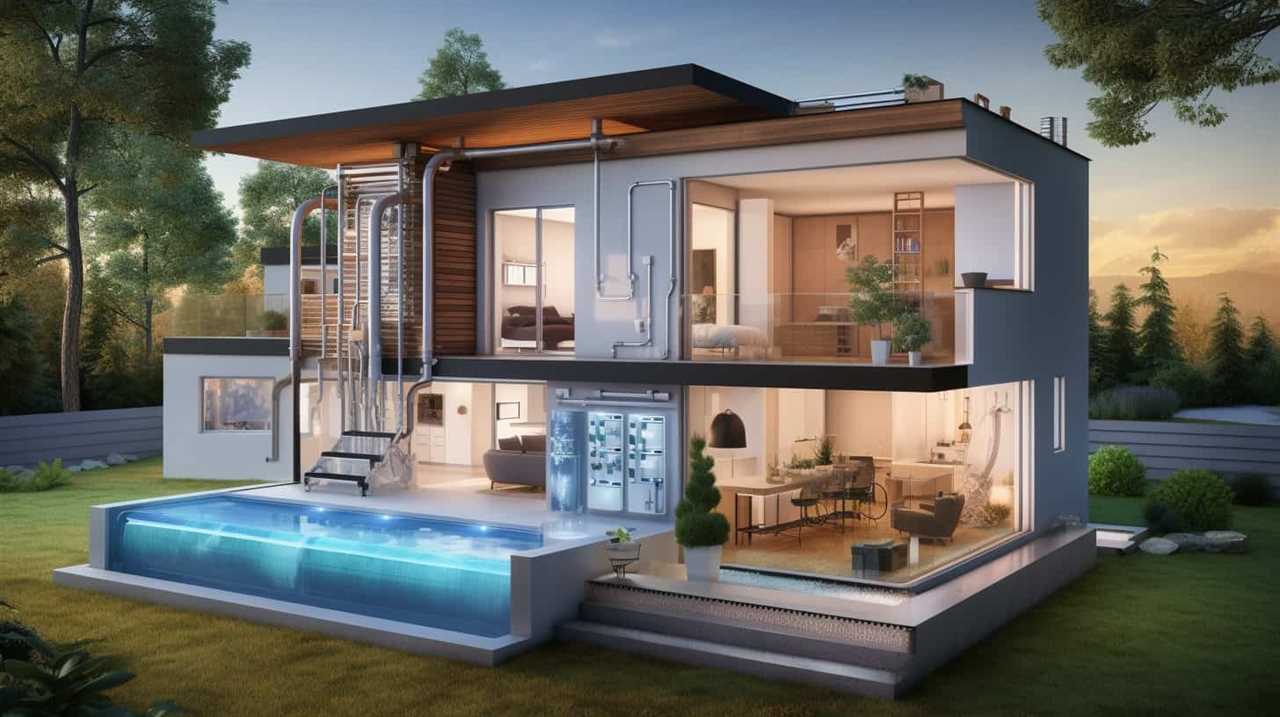
Now, let’s explore how heat pumps extract heat from cold air.
How Heat Pumps Extract Heat From Cold Air
Extracting heat from cold air is a fundamental process in which heat pumps utilize a refrigeration cycle to transfer thermal energy from the outdoor air to the indoor environment. Thanks to advancements in heat pump technology, extracting heat from cold air has become more efficient and effective, making heat pumps a viable option even in cold climates.
Heat pumps work by using a refrigerant that evaporates at a low temperature, absorbing heat from the outdoor air. The refrigerant is then compressed, which increases its temperature and pressure. This high-temperature refrigerant is then passed through a condenser, where it releases the absorbed heat into the indoor space.
The benefits of heat pumps in cold climates include energy efficiency, cost savings, and the ability to provide both heating and cooling. By extracting heat from cold air, heat pumps offer a sustainable and reliable solution for heating homes in cold climates.

Transitioning to the next section, we’ll now explore the challenges of extreme cold temperatures and how heat pumps overcome them.
Overcoming the Challenges of Extreme Cold Temperatures
When it comes to heating in cold climates, efficient performance is crucial. The challenges posed by extreme cold temperatures can hinder the effectiveness of heat pump solutions.
However, with the right strategies and technologies in place, it’s possible to overcome these challenges and ensure optimal heat pump performance even in the coldest winter weather.
Efficient Heating in Cold
We have found that using high-efficiency heat pumps is a cost-effective solution for efficiently heating homes in extremely cold temperatures. Here are some key factors to consider when maximizing heat pump performance in cold weather:
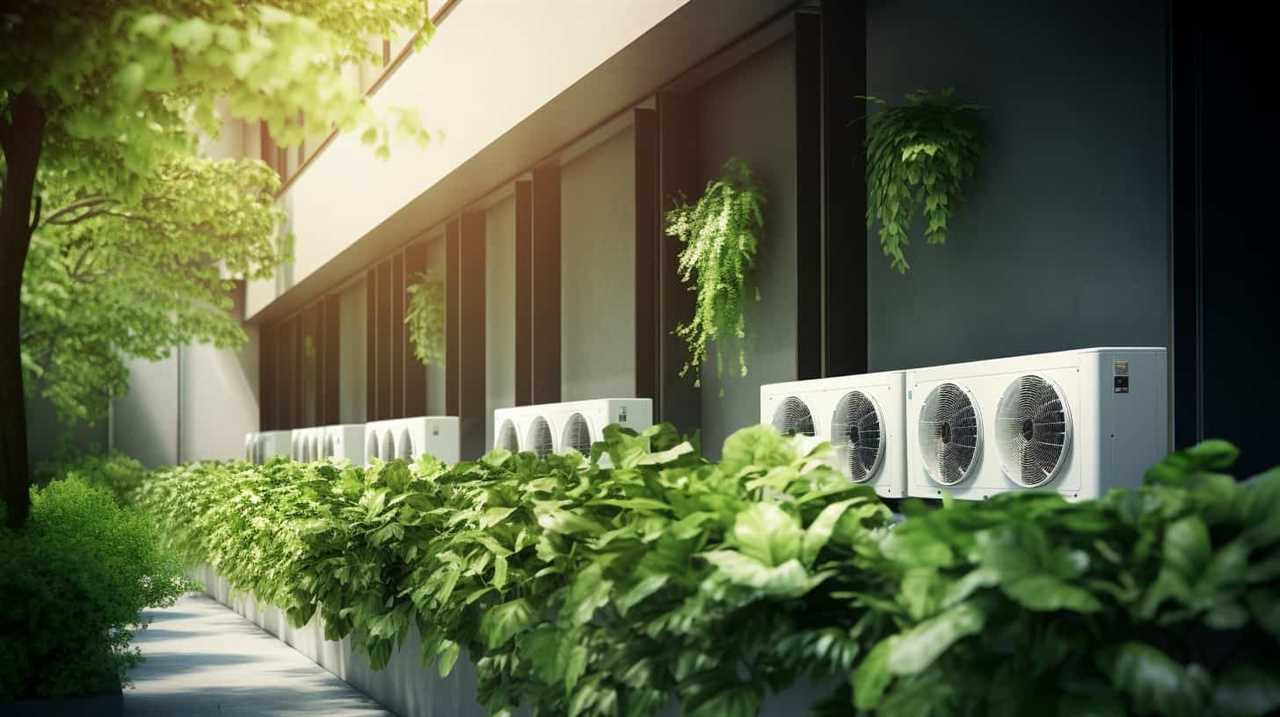
-
Proper insulation: Ensuring that your home is properly insulated will help retain heat and reduce the workload on your heat pump.
-
Supplemental heating: In extremely cold temperatures, it may be necessary to use supplemental heating methods, such as electric resistance heaters or gas furnaces, to provide additional warmth.
-
Regular maintenance: Regular maintenance of your heat pump is crucial to ensure optimal performance. This includes cleaning or replacing filters, checking refrigerant levels, and inspecting the system for any issues.
-
Smart thermostat: Investing in a smart thermostat allows you to control and schedule your heat pump more efficiently, maximizing its performance while reducing energy consumption.
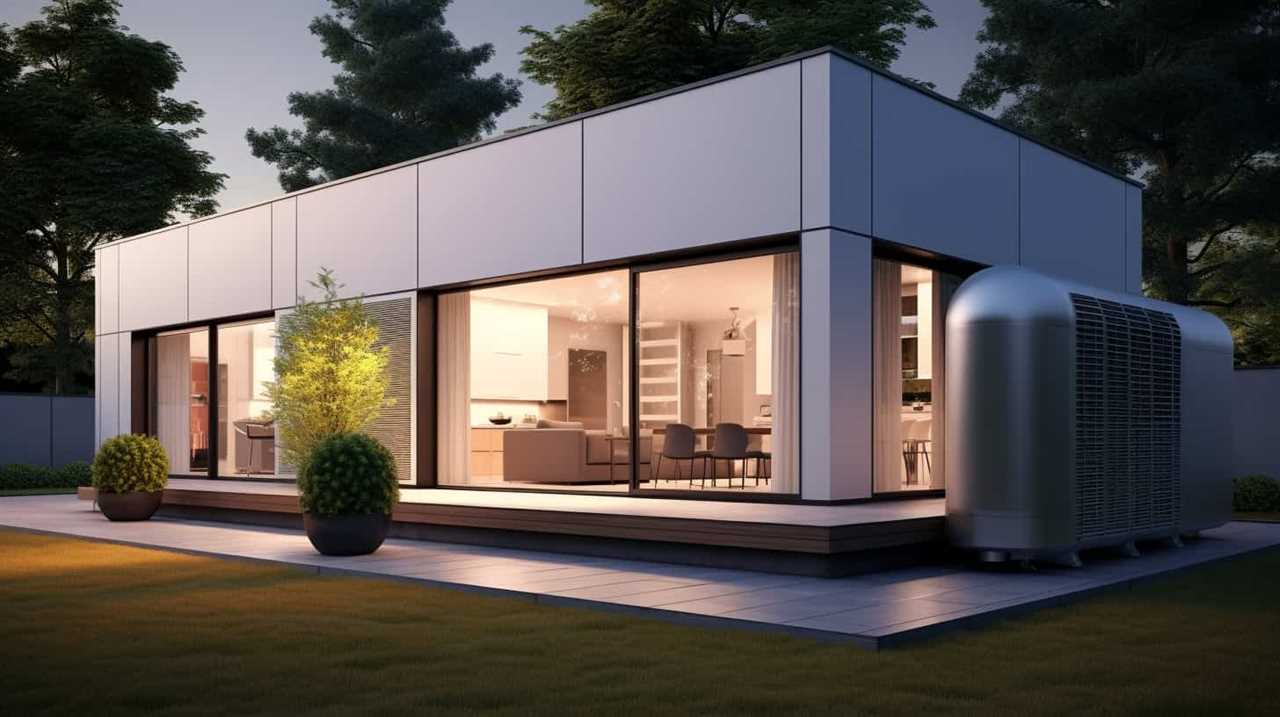
By implementing these strategies, you can overcome the challenges of extreme cold temperatures and achieve efficient heating in your home.
Now, let’s delve into the topic of winter weather performance.
Winter Weather Performance
To ensure optimal performance in extremely cold temperatures, we need to consider strategies for overcoming the challenges posed by winter weather. Overcoming winter challenges is crucial for maximizing heat pump efficiency and providing reliable heating solutions in cold climates.
One effective strategy is to use advanced defrosting technology that prevents the buildup of ice on the heat pump’s outdoor unit. This technology detects ice accumulation and initiates a defrost cycle, melting the ice and restoring the heat pump’s efficiency.
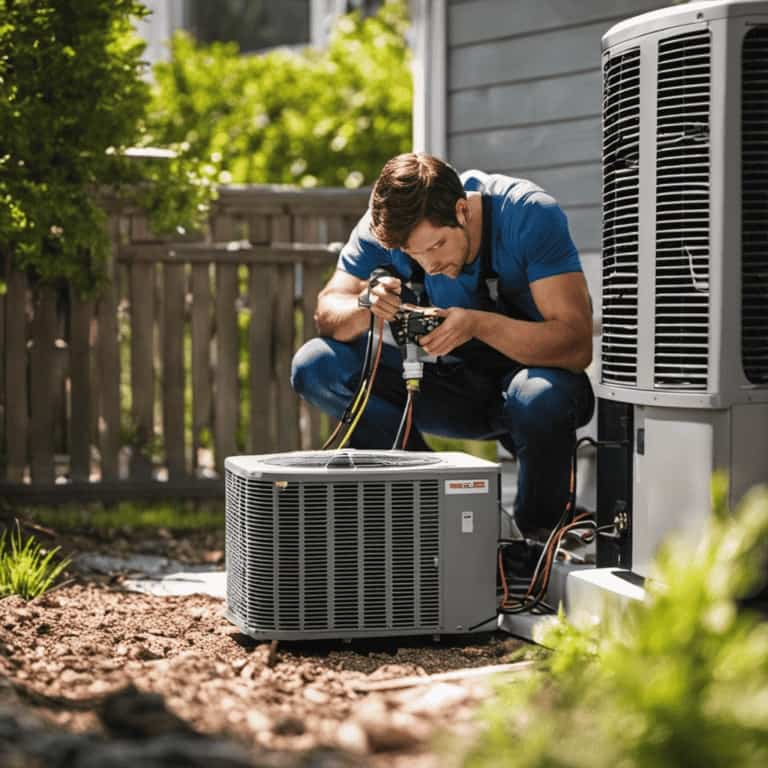
Additionally, insulating the heat pump’s refrigerant lines can help prevent heat loss and maintain efficient operation in cold weather.
It’s also important to ensure proper airflow around the heat pump by clearing snow and debris from the outdoor unit.
Choosing the Right Heat Pump Size for Cold Climate Applications
Our team recommends considering the appropriate heat pump size for cold climate applications. Choosing the right heat pump size is crucial for optimizing performance and energy efficiency in cold weather. Here are some key factors to consider:
-
Heating load calculation: Conduct a thorough assessment of the heating load requirements of your home or building. This includes considering factors such as insulation, square footage, and climate.
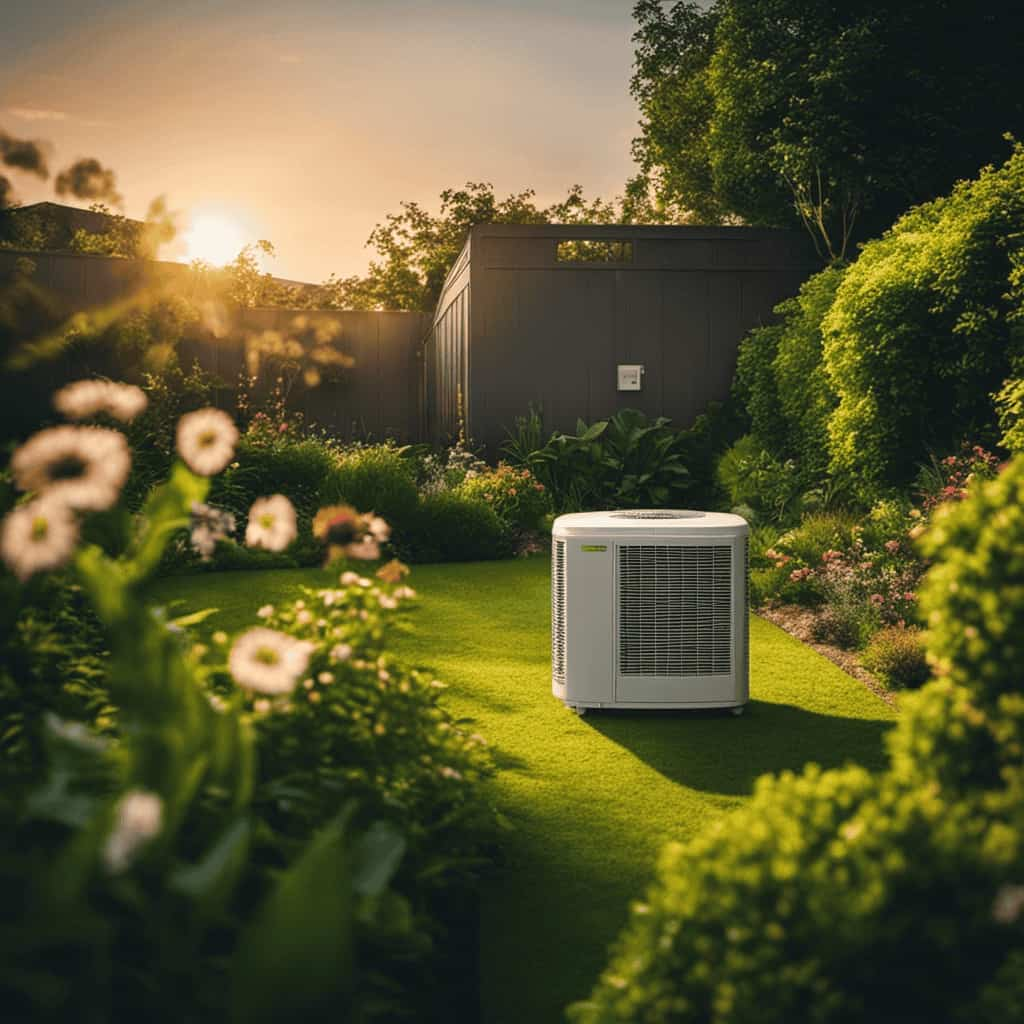
-
Manufacturer specifications: Review the manufacturer’s specifications and recommendations for heat pump sizing. This will ensure that you select a unit that’s suitable for your specific climate and heating needs.
-
Consultation with professionals: Seek the advice of HVAC professionals who specialize in heat pump installation for cold climates. They can provide valuable insights and help you make an informed decision.
-
Consider future needs: Anticipate any future changes in your heating requirements, such as additions to your property or changes in occupancy. Choosing a heat pump that can accommodate these changes will save you money in the long run.
Supplemental Heating Options for Freezing Conditions
Considering additional heating options is essential for combating freezing conditions. In extreme cold challenges, heat pumps may struggle to provide sufficient warmth on their own. Supplemental heating options can help overcome this limitation and ensure comfort in freezing temperatures.
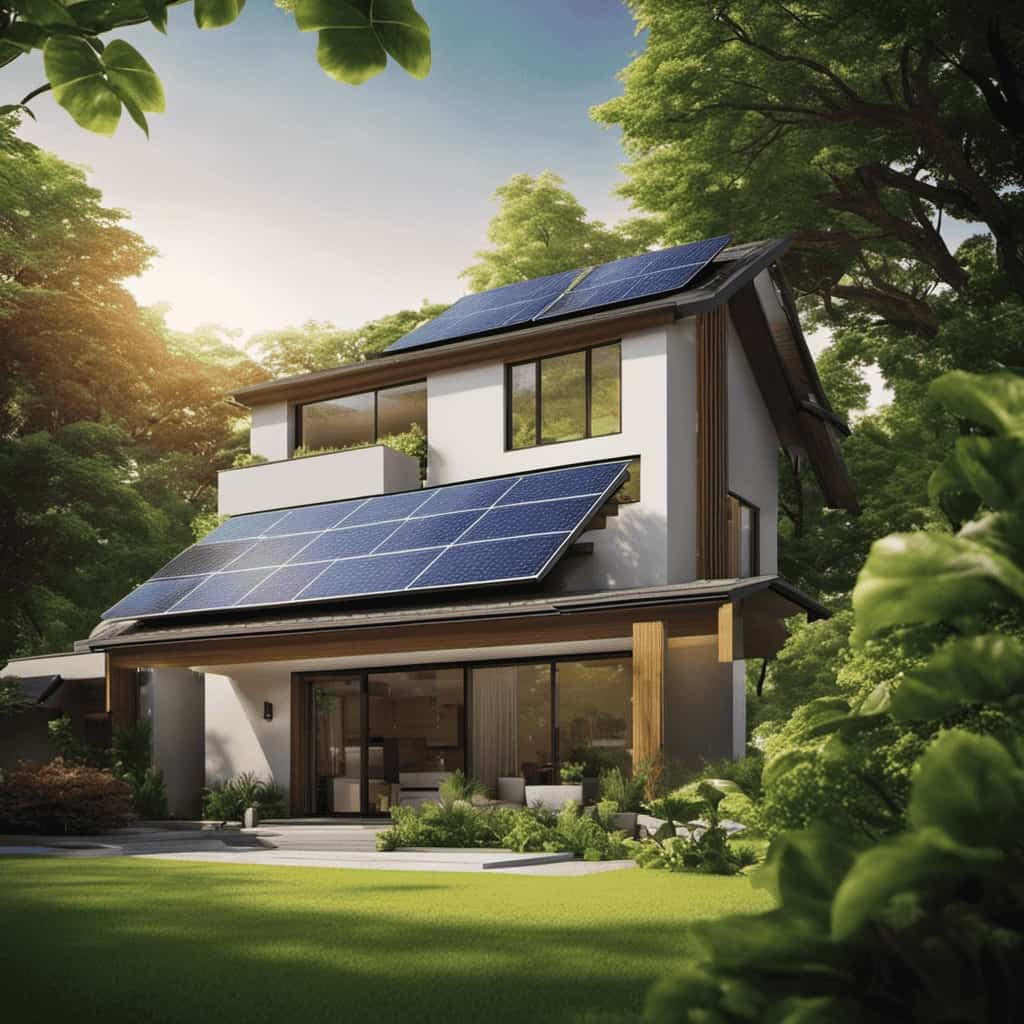
One option is to install electric resistance heaters, which generate heat by passing an electrical current through a resistant material. These heaters can provide quick and powerful heating when needed but can be expensive to operate.
Another option is to use a gas or oil furnace as a backup source of heat. These furnaces can produce high heat output and are often more cost-effective than electric resistance heaters.
By incorporating supplemental heating options, homeowners can ensure optimal comfort even in the coldest conditions.
Transitioning to the subsequent section, let’s now explore the energy savings and cost benefits of heat pumps in cold climates.
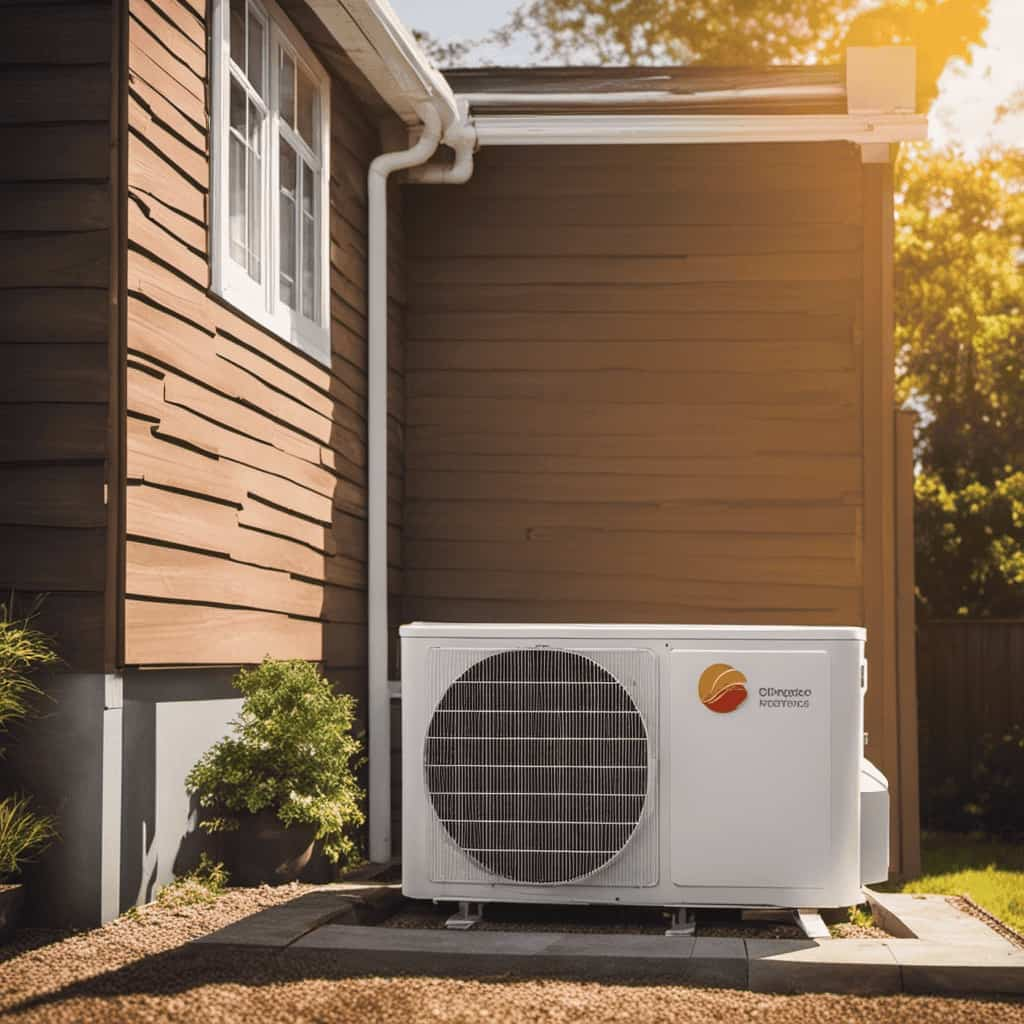
Energy Savings and Cost Benefits of Heat Pumps in Cold Climates
We can achieve significant energy savings and cost benefits by using heat pumps in cold climates. Heat pumps are known for their energy efficiency and can provide long term savings for homeowners. Here are some key reasons why heat pumps are a smart choice in cold climates:
-
Energy Efficiency: Heat pumps use electricity to move heat from the outside air into your home, rather than generating heat from scratch. This process is much more energy efficient than traditional heating methods.
-
Lower Operating Costs: Heat pumps can significantly reduce your monthly energy bills compared to other heating systems. They require less energy to operate, resulting in long term savings.
-
Reduced Carbon Footprint: Heat pumps produce fewer greenhouse gas emissions compared to fossil fuel-based heating systems, helping to reduce your impact on the environment.

-
Government Incentives: Many governments offer financial incentives, such as tax credits or rebates, for installing energy-efficient heat pumps, further reducing the upfront cost.
By utilizing heat pumps, homeowners can enjoy energy savings and cost benefits while also reducing their carbon footprint.
In the next section, we’ll discuss maintenance tips for optimal heat pump performance in the cold.
Maintenance Tips for Optimal Heat Pump Performance in the Cold
When it comes to maintaining optimal heat pump performance in cold climates, there are a few key essentials to keep in mind.
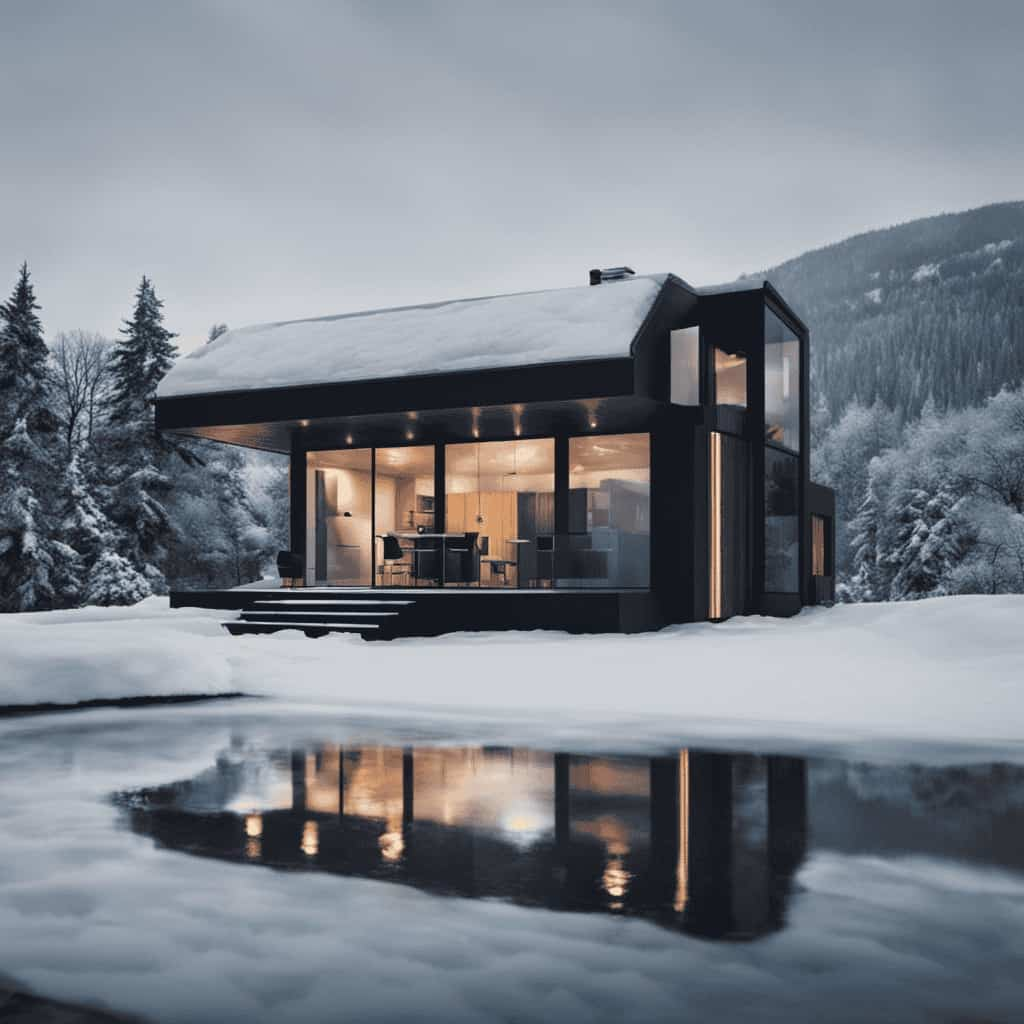
First, make sure to regularly clean and replace air filters to ensure proper airflow.
Additionally, it’s important to check and clean the outdoor unit of any debris or ice buildup.
Finally, consider installing a programmable thermostat to efficiently manage temperature settings and reduce energy consumption.
Winter Maintenance Essentials
Our top priority during the winter is ensuring the heat pump’s longevity and efficiency through proper maintenance. To prevent heat pump freeze up and maintain optimal performance, consider the following winter maintenance tips:
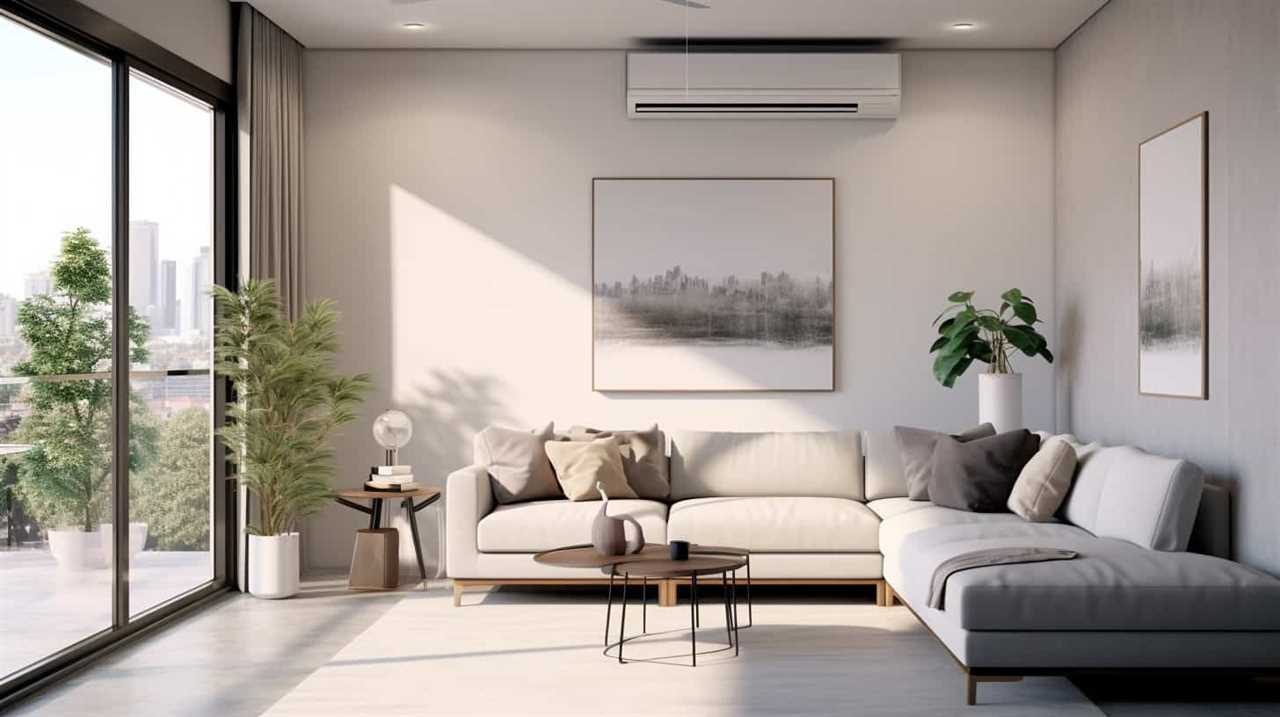
- Regularly clean the outdoor unit to remove any debris or ice buildup that may obstruct airflow.
- Keep the area around the outdoor unit clear of snow, leaves, and other obstructions to ensure proper ventilation.
- Check and replace air filters as needed to maintain good indoor air quality and allow for unrestricted airflow.
- Schedule regular professional maintenance to inspect and tune up the heat pump, ensuring all components are functioning properly.
Cold Climate Efficiency Hacks
To maximize heat pump performance in cold climates, regularly defrosting the outdoor unit is essential. In extreme weather challenges, ice and snow can accumulate on the unit, reducing its efficiency. By removing this buildup, the heat pump can operate at its optimal level and provide consistent heating even in subzero temperatures.
In addition to defrosting, implementing proper insulation techniques is crucial. Insulating the outdoor unit and the refrigerant lines helps prevent heat loss and ensures that the system operates efficiently. Proper insulation also protects the unit from extreme cold, preventing damage and extending its lifespan.
By regularly defrosting the outdoor unit and implementing insulation techniques, homeowners can overcome the challenges of cold climates and maximize the efficiency of their heat pump systems.
Now, let’s explore some case studies of successful heat pump installations in cold climate regions.
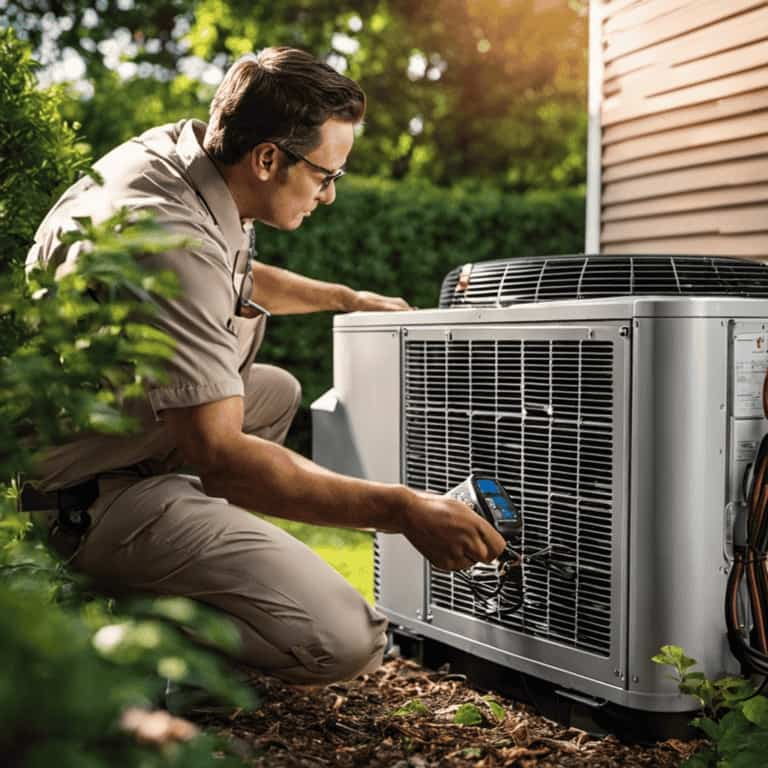
Case Studies: Successful Heat Pump Installations in Cold Climate Regions
We have observed several successful heat pump installations in cold climate regions. These case studies highlight the effectiveness of heat pumps in providing reliable heating solutions even in extreme weather conditions. Here are some key takeaways from these installations:
-
Optimal Sizing: Properly sizing the heat pump system is crucial for optimal performance. Oversized units can lead to short cycling and reduced efficiency, while undersized units may struggle to meet the heating demands. Accurate calculations based on the specific climate and building requirements ensure the system operates at its peak efficiency.
-
Supplemental Heat Sources: In colder climates, it’s essential to have backup heat sources to support the heat pump during extreme weather conditions. These can include electric resistance heaters, gas furnaces, or hydronic systems. When the outdoor temperatures drop significantly, the supplemental heat sources kick in, ensuring continuous warmth inside the building.
-
Cold Climate Accessories: Heat pumps designed for cold climates often come with specialized accessories to enhance performance. These can include low ambient temperature controls, crankcase heaters, and defrost cycles, which prevent ice buildup on the outdoor unit and maintain efficient operation even in freezing conditions.
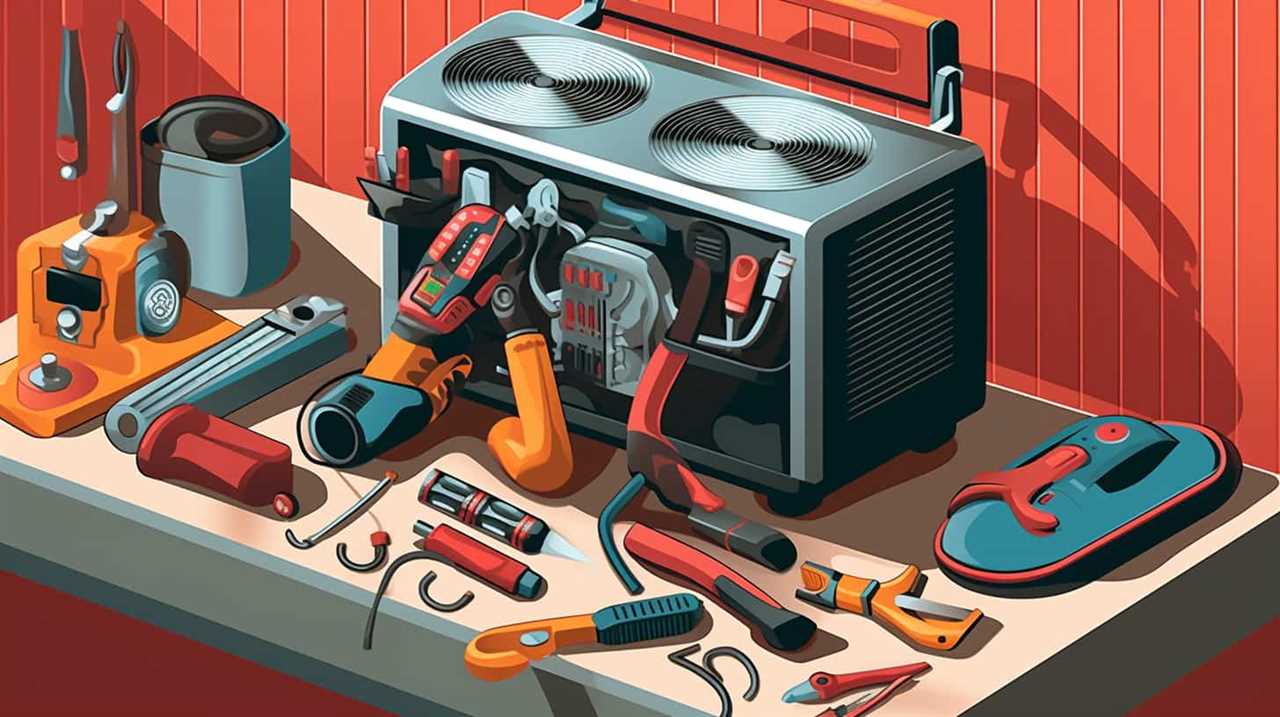
-
Proper Maintenance: Regular maintenance is vital to prolong the lifespan and optimize the performance of heat pump systems in cold climates. This includes cleaning or replacing air filters, inspecting and cleaning coils, checking refrigerant levels, and ensuring proper airflow. Professional maintenance by qualified technicians is recommended to ensure all components are functioning correctly.
Frequently Asked Questions
What Is the Average Lifespan of a Heat Pump in a Cold Climate?
In a cold climate, the average lifespan of a heat pump depends on various factors such as maintenance, usage, and quality. However, best heat pump solutions are designed to withstand extreme temperatures and provide optimal performance.
Can Heat Pumps Be Used in Extremely Low Temperatures, Such as Below Freezing?
Yes, heat pumps can be used in extremely low temperatures, such as below freezing. Despite the challenges, advancements in technology have improved heat pump efficiency, allowing them to provide heating benefits even in cold climates.
Are There Any Government Incentives or Rebates Available for Installing Heat Pumps in Cold Climates?
Yes, there are government incentives and rebates available for installing heat pumps in cold climates. These incentives can help offset the initial cost of installation and provide long-term cost savings through energy efficiency.
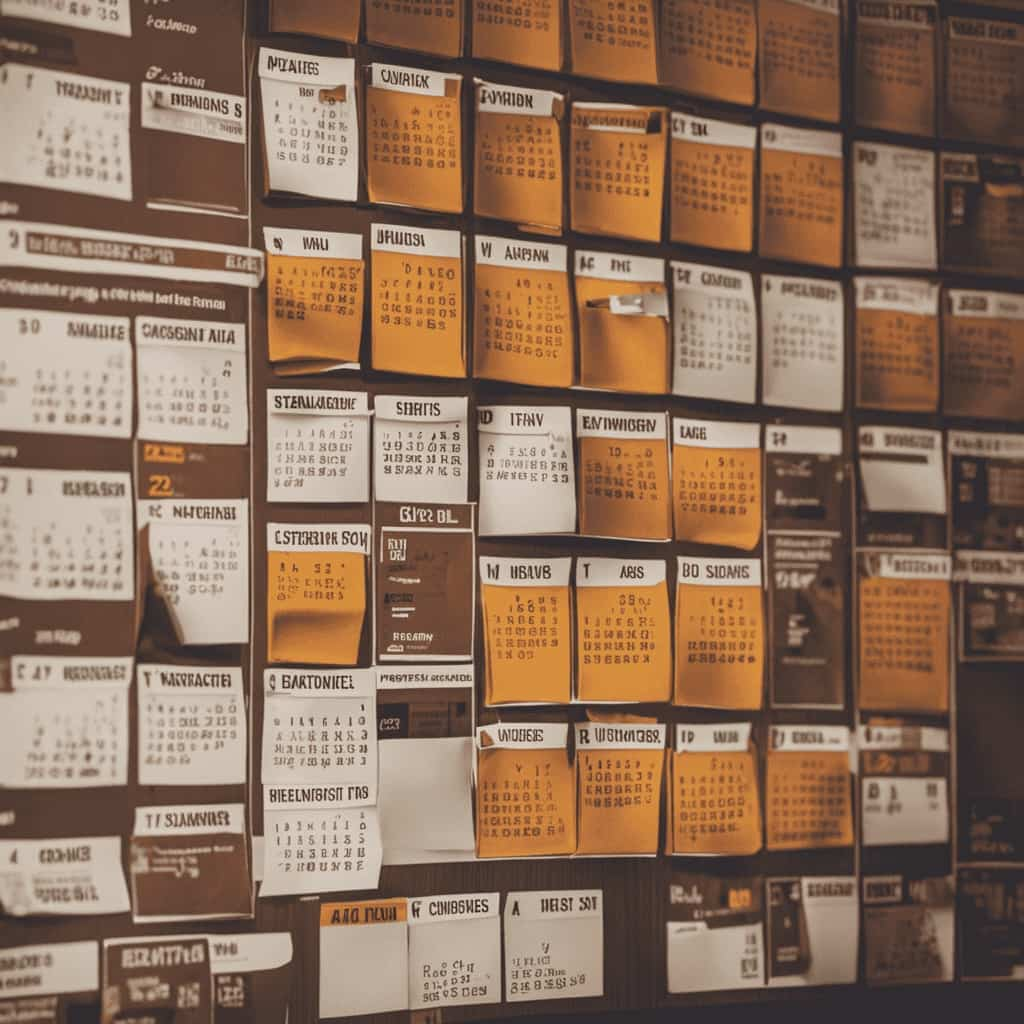
How Noisy Are Heat Pumps When Operating in Cold Climates?
Heat pump efficiency and impact on electricity bills depend on various factors, including the model and insulation. While noise levels can vary, modern heat pumps are designed to operate quietly in cold climates.
Can Heat Pumps Be Used as the Sole Heating Source in a Cold Climate, or Do They Require Supplemental Heating?
Heat pumps can serve as the sole heating source in cold climates, saving money by efficiently converting energy. They are not expensive to operate and offer environmental benefits, reducing carbon emissions and promoting sustainability.
Conclusion
In conclusion, heat pump technology offers efficient heating solutions even in cold climates.
Did you know that heat pumps can extract heat from air as cold as -15°C? This impressive statistic highlights the effectiveness of heat pumps in extreme temperatures.
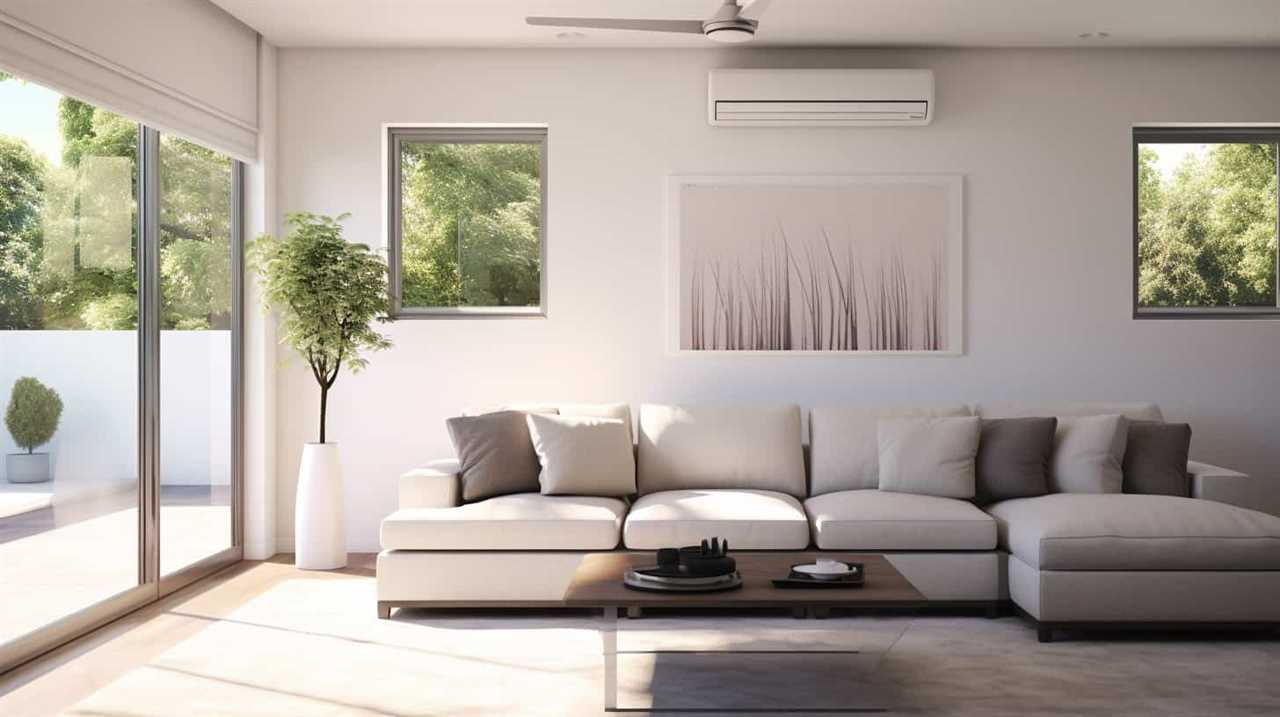
With proper insulation, sizing, and supplemental heating options, heat pumps can provide cost-effective and energy-saving solutions for cold climate applications.
Regular maintenance will ensure optimal performance and longevity of heat pump systems in cold weather conditions.






